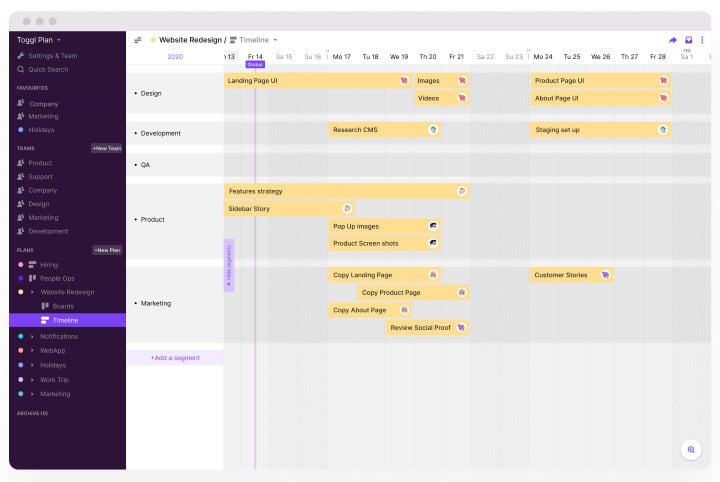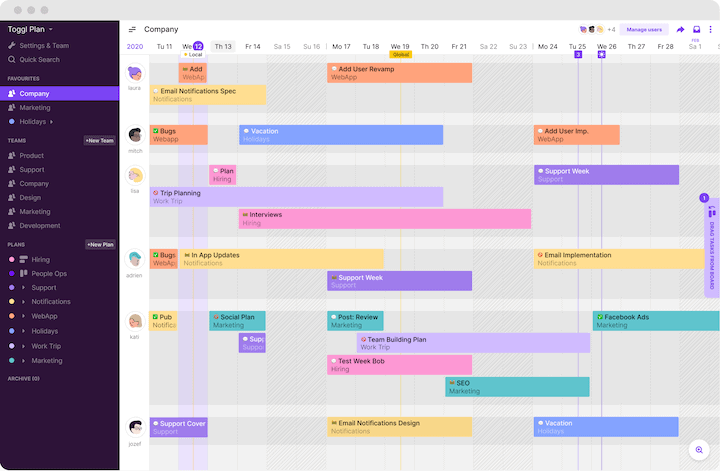Resource allocation in project management deals with finding and assigning the right resources to the right tasks at the right time. Allocating the right resources at the right time could be the difference between project success and failure.
No wonder, according to this Wellingtone report, resource management is the third biggest challenge for project managers.

In this article, you’ll learn:
- What resource allocation in project management is
- Who’s responsible for allocating resources
- Why is it important
- The resource allocation process
- And common resource allocation challenges faced by project managers
Ready to dive in and deliver successful projects, stress-free?
Let’s get started.
What is resource allocation in project management?
Resource allocation is a process in project management that helps project managers identify the right resources, and assign them to project tasks in order to meet project objectives.
Project resources can be material, equipment, financial, or human resources.
Typically, resource allocation is done during the early stages of a project’s lifecycle. Specifically, it’s a step in resource planning, which, in turn, is a step in the project planning phase in project management.
A project manager needs to consider the following factors during resource allocation:
- Skills: the skills that can help achieve the project objectives
- Capacity: the number of theoretical hours a resource can work during the project schedule
- Availability: the number of available resource hours, after excluding time off and culture hours from capacity
- Utilization: the number of productive hours a resource can put in, typically 80% of available hours
Resource planning tools make it easy to identify available resources and allocate them to a project.
Who is responsible for allocating resources in project management?
A project manager is responsible for resource allocation in project management. In larger organizations, resource managers are responsible to allocate resources from the resource pool.
Before a project manager resource planning and allocation, they must:
- Get a sign-off on the project scope.
- Identify all critical project tasks using Work Breakdown Structure (WBS).
- Create a project schedule and a project timeline.
During resource allocation, the project manager must work closely with:
- project stakeholders, including the customers and the project team members
- other project managers, in cases where multiple projects share the same resources
- identified resources to determine if their capacity and availability are in line with project objectives
Large organizations often have dedicated resource management teams. In such cases, the project manager needs to work closely with resource managers to ensure that resource requirements are met.
Why is resource allocation important in project management?
The benefits of following the right resource allocation process in project management include:
Efficient resource utilization
Assigning resources the right way ensures that limited resources are used in the best possible way to achieve the project’s goals. It helps make the most effective use of the team’s capacity among different projects and tasks.
Mitigate resource risks
Proper allocation of resources helps identify resource constraints that can cause project delays. It enables managers to anticipate potential risks and take remedial measures. Thus improving the chances of project success.
Reduces scheduling conflicts
Time off and shared resources across multiple projects often result in scheduling conflicts. Planned resource scheduling ensures that the project timelines don’t conflict with resource availability. In addition, it takes care to minimize resource dependencies while ensuring that the project stays on track.
Improved cost management
Deliberate resource allocation helps project managers track progress, and manage resource costs, which leads to better cost management. As a result, it reduces the possibility of the project budget going overboard.
Better project outcomes
Effective resource management leads to fewer project failures. When the right resources are assigned to the right tasks, it results in better project outcomes. As a result, project goals are met within the timeline and budget.
Improved project team productivity
Done right, resource assignment ensures optimum resources are allocated and avoid overallocation. This, in turn, prevents overwork, stress, and burnout. As a result, team productivity improves.
3 resource allocation strategies in project management
A resource allocation strategy is a method by which a project manager ensures the right resources are assigned to a project and its tasks. Three popular resource allocation strategies include:
Critical Path Method (CPM)
Using this resource allocation strategy, a project manager identifies tasks that cannot be delayed without delaying the project schedule. Then the project manager prioritizes the best available resources for these critical tasks.
The biggest advantage of CPM is that it ensures the project’s time constraints are met.
However, it does not allow multi-tasking. As a result, while time constraints are met, resources need to be allocated for a longer duration than necessary.
Critical Chain Method (CCM)
The Critical Chain Method is a newer resource allocation technique. Its focuses on resource constraints instead of time constraints like in CPM.
Considering resource availability and constraints, a buffer time is added to the initial project estimate. This allows project teams enough time to complete the project on time.
Some managers use CCM along with CPM.
Resource leveling and smoothing
Things don’t always go according to the resource allocation plan—An emergency means a team member is no longer available. A task takes much longer than estimated. Or something else happens that throws your project timeline off.
In such situations, a project manager can do little else but change the initial project plans.
In resource leveling, a project manager changes the project schedule, including the start and end dates, to account for resource availability.
However, that’s not possible with all projects. In such cases, the project manager uses resource smoothing—They change the resource schedule and allocation plan, or in extreme cases, bring in more resources.
How to allocate project resources effectively?
The project resource allocation process involves identifying and assigning the necessary resources to complete a project successfully. Here are the steps involved:
Step 1: Identify project requirements
Start by identifying the project requirements, including the scope, objectives, and deliverables. This is the first step to identifying resource requirements.
Step 2: Map out the project schedule on a timeline
Next, identify the major tasks needed to complete the project. The Work Breakdown Structure, or WBS in short, is a reliable framework for breaking down a project into deliverables and tasks.
Once you know all the tasks, identify dependencies and estimate how long each task will take.
Based on the estimates and the project requirements, make a project schedule and map it on a timeline.
This may seem like a lot of work. But, creating a project timeline with Toggl Plan is really easy. You can import all your tasks in a CSV file and then simply drag and drop the imported tasks to create a beautiful-looking timeline.

Step 3: Define resource requirements
Now that you know what tasks must be done to deliver the project, you’re ready to define the resource requirements.
You need to identify both, the quality and quantity of resources needed. The quality of human resources can be judged based on skills, experience, and certifications. While quantity simply means the number of people or other resources needed to deliver a task or a project.
Step 4: Allocate resources
Armed with the information in the first three steps, you’re now ready to dip into the resource pool. The resource pool is where you’ll find all the available resources within your company.
For effective resource allocation, look out for resources that:
- Aren’t on other assignments,
- Aren’t on an absence such as a holiday,
- And meet any time zone restrictions the project may have.
Some team members (for example, designers in a web design agency) often work on multiple projects at the same time. In such cases, you want to reevaluate resource availability based on their allocation to other projects.
Just like the Project timeline, Toggl Plan also has a team timeline.
This makes it really easy to identify available resources. On the team timeline, you can see what each team member’s schedule looks like, across projects and their time off plans.

Step 5: Monitor resource utilization
In spite of all the planning, things could still go wrong. Project scope changes, emergency time off, or task delays can throw your best project resource plan off.
That’s why you must constantly monitor resource utilization to identify over or under-utilized resources. Monitoring helps you:
- Release unused or under-allocated resources
- Use resource leveling or smoothing to get over the resource crunch
It also helps to have a backup resource allocation plan when nothing else works. For example, you could hire freelancers or outsource work to partners.
Today, most project management software comes with features to track resource utilization. Alternatively, you can use a resource loading chart.
Common resource allocation challenges and solutions
We live in a world where change is constant. And, to deliver projects on time, you need to adapt your plan constantly. That’s what makes resource allocation so difficult.
Here are some common problems that can trip you.
Changes in project scope
Workloads can change at any moment. Scope changes will undoubtedly lead to your resource requirements changing, so you need a resource allocation plan that’s flexible.
Solution: Fully assess scope changes before they’re approved. Then identify if the current resource allocations remain sufficient or whether changes are required.
Changes in resource availability
Resource allocation is rarely static and there are many scenarios that bring changes. Whether that’s a team member off sick or a late supplier delivery, try to factor contingency into the resource allocation process.
Solution: When building your initial project plan, try to factor in some resource contingency. This will give you room to maneuver for minor changes. If the consequence is major, take immediate action to source replacements.
Task delays
No piece of work is without its dependencies. That’s why a delay in one task has a cascading effect on other tasks, sometimes across projects. Because of this, you lose your resource availability window.
Solution: When building your initial project plan, identify key dependencies and make contingency plans for those resources.
Level up your project management with efficient resource allocation
Every one in four projects fails, because of resource dependencies.
Understanding how to allocate resources and planning project resources can be the difference between a successful and a failed project. That’s why resource allocation becomes so critical.
Also, allocating resources is not a one-time planning phase activity. Situations change. And, that’s why the need to monitor your resource plans continuously.
Toggl Plan is a beautifully simple project planning tool that can help you manage your resources and deliver a project on time.
Sign up for a free 14-day trial account.
Jitesh is an SEO and content specialist. He manages content projects at Toggl and loves sharing actionable tips to deliver projects profitably.


![What is Project Resource Management? [Comprehensive Guide]](images/project-resource-management-674x404.jpg)